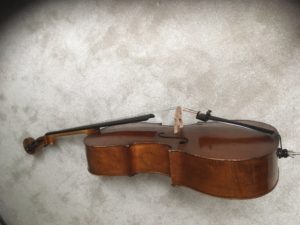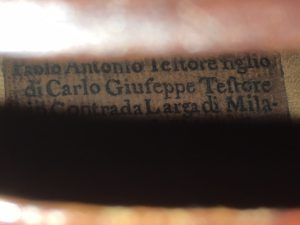
Anne Gastinel.
Anne Gastinel Bach Cello Suites (Naive) Rec.2007 V5121.
The Cellist.
Given her Gallic heritage, it is perhaps no surprise to find that Paul Tortelier numbered amongst her teachers. However, she also studied with Janos Starker. It is perhaps his influence that most comes to my mind on hearing these interpretations. This is not because there are significant similarities to say his Mercury recording of the suites. More that it is clear a significant intellect is at work in Gastinel’s renderings.
I don’t find she is playing to any received tradition, but rather she appears to be deeply involved in the music. To my mind, she almost recreates the suites on the spot.
The Music.
That I was not in for any cookie cutter reading is evident from the off. Her approach to the 1st Suite Prelude is individualistic. Not for her the smoothing out the lines, to create perhaps the most well known melody from the set. An example being for instance Tortelier in his 1980’s EMI recording. Instead there is real pace to Gastinel’s view, including jagged rhythms to the shorter notes leaving a movement full of nervous energy.
A further example is the 1st Suite’s Courante. even though it is meant to be a rapid gliding dance, only whirling dervishes need apply!
Not everything is done at a frantic pace though. Such a consistency would be too simple for Gastinel who is responding to the pieces as she goes along and as she sees fit. In fact the 5th Suite Gigue for instance feels a mite too slow given its Jig heritage.
Her 2nd Suite Prelude is worthy of comment too. She adopts a subtle rubato, that in this instance brings to mind a rocking motion which I find very effective. Having said that it takes a bit of getting used to!
My final comments on her readings relate to the great 6th Suite. Given some of her earlier movements I did worry she might inject pace at the wrong moments (at least for me). Actually this was not the case. Her Allemande was very broad and deeply moving. As for the Sarabande, I currently know of no other comparable recording on disc. She thins out the sound wonderfully, and it proves sublime in its simplicity.
The Recording.
Turning to the recording I have bouquets but also brickbats. The cello sound itself is wonderful natural, perhaps in no small part down to the wonderful instrument used. This is a 1690 Testore (practically as old as Bach himself!). For sure it would have been interesting to have heard Gastinel set down readings with Casals’ Goffriller which she was once the custodian of, but the Testore banishes any thoughts of being short changed. I have to assume though that the cello and cellist were very closely miked as there are plenty of instances of my dreaded “tippy tappy” playing. Gastinel’s breathing is also prominent throughout. Whilst in the early parts of her recording that didn’t cause me undue concern it did start to irritate as the suites progressed, reaching a pinnacle in the 4th Suite Sarabande, where frankly I feared she might expire before she reached the end….
Conclusion.
In spite of the acoustic reservations though, this is another set I am very happy to be acquainted with, as Anne Gastinel clearly has something unique to say about the suites and I am very happy joining her on that journey.
Mark.
Anne Gastinel. Naïve V5121 CD
Recorded in July and September 2007 at Studio Tibor Varga, Sion (Switzerland).
Recorded digitally in High resolution 24bit/96Hz file
General comments of the recording.
The technical quality of this recording is exemplary, with just the right degree of echo, and a wide soundstage, clearly imaging the cello centrally.
There is no harshness to the top register and the low notes are full with no bloom. It helps that Gastinel’s tone is superb and unforced, but this is one of the best recordings of the cello that I am aware of. The recording quality is clearly of the upmost importance to the production team, as there is detail of the microphones and recording equipment in the CD booklet.
The booklet also contains a very flowery essay about Gastinel and her custodianship of Casals’ Goffriller cello.
She now plays a Testore cello which apparently accounts in part to the lovely tone particularly at the lower frequency range. This particularly interested me as I too have a Testore labelled cello! Before you question why a rank amateur should own such a wonderful instrument I would hasten to add that it is a fake (label), but I attach a photo to prove my case.
The Music.
Although Gastinel, who has had tutorage from the likes of Tortelier was only 36 years old when recording the Bach Suites, her performance is outstanding. For me, overall, it feels a very calm, considered, and at times almost languid rendition.
However, the performances are never boring, holding the attention at all times. There are movements particularly the Gigue and the second Gavotte of the 5thSuite when this cellist demonstrates the ability to more than match some of the heavy weights with flair and bravura.
I particularly like the tendency Gastinel has to pause a fraction of a second before leaning into each bass note in a sequence of notes, within each phrase. If this does not appeal to one it might be somewhat irritating after time, but for me it enhances her performance.
Others may also take exception to the significant rubato applied particularly to the preludes. I feel this adds to the ebb and flow of the music but purists may frown.
Generally, there are no surprises with tempo of the various movements, although the Sarabandes tend to be less slow than many. The Courantes and Bourrees are brisk but perfectly articulated, never feeling rushed or blurred.
Conclusion.
In summary, one of my favourites and if you enjoy the slight quirks mentioned above, I’m sure will be popular with many.


Charles.